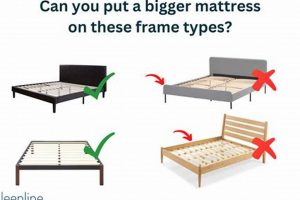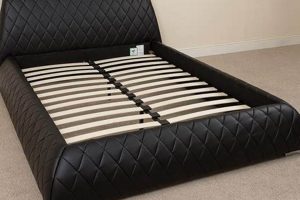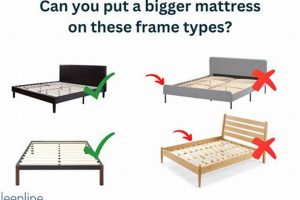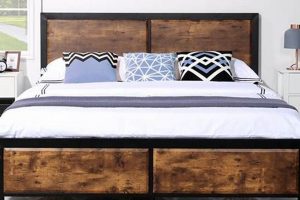Maintaining a mattress securely in place on a metal bed structure is essential for a restful and undisturbed sleep experience. A mattress that consistently shifts can lead to discomfort, disrupted sleep patterns, and potential damage to both the mattress and the frame. This problem can manifest as a subtle nightly creep or a more dramatic slide, ultimately impacting the overall quality of rest.
Addressing this issue is important because a stable sleeping surface contributes significantly to proper spinal alignment and reduced back pain. Historically, various solutions have been employed, ranging from rudimentary fixes like placing rugs underneath the frame to more sophisticated methods involving specialized grips and fasteners. The effectiveness of a solution directly correlates to the stability and longevity of the bed setup.
The following sections will delve into practical methods for ensuring mattress stability on a metal support structure. These strategies include utilizing non-slip materials, employing physical barriers, and modifying the frame itself to provide a more secure fit. Each method offers a unique approach to preventing movement and enhancing the overall stability of the bedding arrangement.
Methods to Stabilize a Mattress on a Metal Frame
Securing a mattress to a metal bed frame is crucial for stability and preventing unwanted movement. The following methods offer effective strategies for achieving this goal:
Tip 1: Utilize Non-Slip Mattress Pads: These pads, typically constructed from rubber or textured materials, create friction between the mattress and frame. Place the pad directly between the two surfaces to inhibit slippage. Available in various sizes, these pads offer a simple and cost-effective solution.
Tip 2: Employ Mattress Grippers or Straps: Specifically designed grippers attach to the corners of the mattress and frame, providing a secure anchor. Similarly, straps can be wrapped around the mattress and frame, tightening to minimize movement. Ensure proper tension to avoid damaging the mattress.
Tip 3: Implement a Non-Slip Rug or Mat Under the Frame: Placing a rug or mat with a non-slip backing under the metal frame increases friction with the floor. This reduces the likelihood of the entire bed frame, and consequently the mattress, from shifting. Select a material that is compatible with the flooring surface.
Tip 4: Add a Headboard and Footboard: A headboard and footboard act as physical barriers, preventing the mattress from sliding lengthwise. Ensure these components are securely attached to the metal frame for optimal effectiveness. Choose dimensions that closely match the mattress size.
Tip 5: Secure with Hook-and-Loop Fasteners: Industrial-strength hook-and-loop fasteners, such as Velcro, can be applied to both the mattress and frame. Adhere one side to the frame and the corresponding side to the mattress. This creates a strong bond that resists movement. Exercise caution when removing the mattress to avoid damaging the fabric.
Tip 6: Modify the Frame with Rubber or Foam Inserts: Applying rubber or foam inserts to the areas where the mattress contacts the frame can enhance grip. These inserts create a cushioning effect while simultaneously increasing friction. Ensure the inserts are securely attached to the frame to prevent displacement.
These strategies collectively contribute to a more stable and secure sleeping environment. The selection of a particular method will depend on the specific frame design and the severity of the movement problem.
Implementing these techniques effectively addresses the concern of mattress instability. A stable mattress promotes restful sleep and extends the lifespan of both the mattress and the bed frame.
1. Friction Enhancement
Friction enhancement plays a central role in preventing mattress movement on a metal bed frame. The primary objective is to increase the resistive force between the mattress and the frame’s surface, thereby inhibiting slippage and maintaining a stable sleeping platform.
- Non-Slip Mattress Pads
These pads, constructed from materials like rubber or textured polymers, are placed directly between the mattress and the metal frame. Their elevated coefficient of friction creates a substantial resistance to lateral movement. The effectiveness depends on the pad’s surface area, material composition, and the weight distribution of the mattress. For instance, a pad covering the entire frame surface provides greater stability than smaller, strategically placed pieces.
- Textured Frame Modifications
Applying textured coatings or inserts to the metal frame itself can also enhance friction. This might involve adhering rubber strips, applying a textured paint, or inserting foam padding. The chosen material should be durable and resistant to compression, ensuring long-term effectiveness. An example would be applying a rubberized coating to the frame’s slats, which directly contact the mattress, to increase grip.
- Mattress Surface Treatments
While less common, treatments applied directly to the mattress’s underside can also increase friction. These treatments might include spray-on adhesives or the application of textured fabrics. However, it’s crucial to consider the potential impact on the mattress’s breathability and structural integrity. A carefully applied, non-toxic adhesive could provide a temporary increase in friction without causing permanent damage.
- Weight Distribution and Surface Area
Effective friction enhancement also relies on even weight distribution across the mattress surface. Uneven weight distribution can concentrate force on specific areas, reducing the overall effectiveness of frictional elements. Ensuring adequate surface area contact between the mattress and the frame is equally important. A mattress that is significantly smaller than the frame will be inherently less stable, regardless of the friction-enhancing methods employed. For example, a memory foam mattress conforms to the shape of surface which maximize contact area and also help increase the friction.
In conclusion, friction enhancement is a multifaceted approach to mattress stabilization. The selection and implementation of appropriate methods, combined with attention to weight distribution and surface area, are essential for achieving a secure and stable sleeping arrangement. Neglecting these factors can lead to continued mattress movement, despite the application of seemingly effective solutions.
2. Physical Barriers
Physical barriers represent a direct method for preventing mattress movement on a metal bed frame. These barriers function by creating a physical impediment that restricts lateral displacement of the mattress. The presence of such barriers converts a potentially unstable system into one with defined boundaries, significantly reducing the risk of slippage.
The implementation of physical barriers often involves the integration of a headboard and footboard with the metal frame. These components, when securely attached, create a perimeter that contains the mattress. For example, a metal frame equipped with a properly sized headboard and footboard prevents the mattress from sliding beyond the frame’s designated boundaries during sleep. The effectiveness of these barriers depends on their height, rigidity, and secure attachment to the frame. Insufficient height allows the mattress to potentially ride over the barrier, while a lack of rigidity can lead to the barrier itself shifting under pressure. Furthermore, inadequate attachment compromises the entire system’s integrity.
Alternative physical barriers include side rails that extend upwards along the frame’s sides. These rails, typically constructed from metal or wood, provide lateral support and prevent side-to-side movement. An example of practical application is the use of raised edges along the metal frame’s surface. This is commonly found in platform beds which include frames made out of wood. While providing a minimal physical barrier, raised edges ensure the mattress remains within the frame’s boundaries, preventing slippage. These solutions are most effective when combined with other methods like non-slip pads. Physical barriers offer a straightforward and effective solution to mattress instability, playing a crucial role in creating a more secure and comfortable sleeping environment.
3. Frame Modification
Frame modification, in the context of preventing mattress slippage on a metal bed frame, involves altering the physical structure of the frame to enhance its ability to secure the mattress. This approach acknowledges that inherent design limitations may contribute to the problem and seeks to address these limitations directly.
- Adding Slats or Support Bars
Many metal frames feature widely spaced slats, which provide insufficient support and allow the mattress to sag or shift between the gaps. Modifying the frame by adding additional slats or support bars increases the contact area between the frame and the mattress, distributing weight more evenly and reducing the likelihood of movement. Steel or wood slats securely attached to the existing frame structure are typical implementations. This reduces gaps where the mattress can dip into, directly reducing shifting and instability.
- Integrating Raised Edges or Lips
Welding or attaching raised edges or lips to the perimeter of the metal frame creates a physical barrier that prevents the mattress from sliding off the sides. These edges, typically made of metal or sturdy plastic, act as guides, keeping the mattress within the frame’s boundaries. The height of the edges must be sufficient to contain the mattress without being obtrusive or uncomfortable. The application can be seen when metal frames being converted to a platform bed where the lip runs around the frame.
- Applying Non-Slip Coatings or Materials
Modifying the surface of the metal frame with non-slip coatings or materials enhances friction and reduces slippage. This can involve applying a rubberized coating, adhering non-slip tape, or installing foam padding to the areas where the mattress makes contact with the frame. The choice of material should consider durability, compatibility with the mattress material, and resistance to compression. It creates higher coefficient of friction to avoid mattress from slipping.
- Adjusting Frame Dimensions
In some cases, the dimensions of the metal frame may not precisely match the size of the mattress, leading to instability. Modifying the frame to achieve a tighter fit can significantly reduce movement. This may involve cutting and welding the frame to reduce its overall size or adding extensions to fill gaps. Proper measurement and precise execution are essential to avoid compromising the frame’s structural integrity. Modification on its measurement, it would create tighter space around the mattress and avoid slipping issue.
These frame modification strategies offer direct solutions to the problem of mattress slippage by addressing the underlying design or dimensional deficiencies of the metal frame. Implementing these modifications requires careful planning, appropriate materials, and secure execution to ensure the frame’s structural integrity and the long-term stability of the mattress.
4. Secure Fastening
Secure fastening, as a method of ensuring mattress stability on a metal frame, directly addresses the issue of unwanted movement through the application of physical restraints. These restraints actively connect the mattress to the frame, preventing displacement regardless of external forces or internal mattress shifting.
- Straps and Buckles
This approach involves the use of adjustable straps, typically made of durable nylon or similar materials, that encircle both the mattress and the frame. Buckles or tensioning mechanisms on the straps allow for tightening, effectively compressing the mattress against the frame and preventing slippage. An example is the use of corner straps that anchor to each corner of the mattress, pulling them downwards and inwards towards the frame. The effectiveness relies on the strap material’s strength, the buckle’s reliability, and the appropriate level of tension without deforming the mattress.
- Hook-and-Loop Systems
Hook-and-loop fasteners, such as Velcro, offer an alternative fastening method. Strips of hook material are adhered to the metal frame, while corresponding loop strips are attached to the underside of the mattress. When pressed together, these strips create a secure bond that resists lateral movement. Industrial-strength hook-and-loop fasteners are recommended for this application due to their superior holding power. A common application involves attaching these strips along the perimeter of both the mattress and the frame to provide comprehensive restraint. The system’s integrity depends on the adhesive strength, the hook-and-loop density, and the surface area of contact.
- Clip-On Fasteners
Specially designed clip-on fasteners offer a more direct mechanical connection between the mattress and frame. These fasteners typically consist of two interlocking components: one that attaches to the frame (often clipping onto a slat or rail) and another that secures to the mattress (either through fabric loops or a similar attachment method). A practical example involves using spring-loaded clips that grip the mattress’s edge and simultaneously hook onto the metal frame’s support beams. This method is particularly effective when the frame has pre-existing holes or attachment points. The effectiveness of clip-on fasteners depends on the clip’s material strength, the security of the attachment mechanisms, and the compatibility with both the mattress and frame designs.
- Integrated Fastening Systems
Some modern metal bed frames incorporate integrated fastening systems designed specifically to secure the mattress. These systems might include recessed channels in the frame for accepting mattress edges, built-in straps with quick-release mechanisms, or magnetic locking systems. An example would be a metal frame with a series of adjustable pins that can be inserted into corresponding holes in the mattress to prevent movement. Such systems offer a more seamless and aesthetically pleasing solution compared to aftermarket fastening methods. The reliability hinges on the system’s design, the quality of the materials used, and the precision of the manufacturing process.
In summary, secure fastening techniques offer a proactive approach to preventing mattress movement. The selection of an appropriate method depends on the specific frame design, the type of mattress, and the desired level of security. While straps, hook-and-loop systems, and clip-on fasteners offer versatile solutions, integrated fastening systems represent a more permanent and often more elegant approach. Regardless of the chosen method, secure fastening contributes significantly to a more stable and comfortable sleeping experience.
5. Weight Distribution
Weight distribution plays a pivotal role in mattress stability on a metal frame. Uneven weight distribution contributes significantly to mattress slippage, while balanced distribution promotes stability. Understanding the principles of weight distribution and their application to bedding arrangements is crucial for effectively addressing the issue.
- Even Load Distribution and Friction
When weight is evenly distributed across the mattress surface, it creates a consistent frictional force between the mattress and the frame. This uniform friction resists lateral movement. In contrast, concentrated weight in specific areas reduces friction in other regions, making the mattress more susceptible to sliding. For example, if one individual consistently sleeps on one side of the bed, that side will experience greater compression and reduced friction compared to the other side. The result is increased likelihood of slippage toward the less-weighted side. A mattress with internal zoning to account for body weight differences can mitigate this.
- Slat Spacing and Support
The spacing and arrangement of slats on a metal frame directly impact weight distribution. Widely spaced slats provide inadequate support, allowing the mattress to sag between the gaps. This sagging creates localized stress points and uneven weight distribution, increasing the risk of slippage. A frame with closely spaced slats or a solid platform provides more uniform support, distributing weight evenly and reducing stress points. This is directly applicable in metal framed beds; the closer the metal bars/slats are, the less likely for the mattress to slide.
- Mattress Construction and Material Properties
The internal construction and material properties of the mattress also influence weight distribution. Mattresses with inconsistent density or uneven layering may exhibit localized compression and uneven weight distribution. For example, a mattress with a thick layer of soft foam on top of a firmer core may compress significantly under pressure, creating a localized low point and promoting slippage. Mattresses designed with zoned support, utilizing varying densities of foam or coil systems, can better distribute weight and resist uneven compression. A pocketed coil system, for example, better conforms to the body, creating less localized pressure. Innerspring coils, on the other hand, are more rigid and can create pressure areas for heavier individuals.
- Frame Alignment and Leveling
A misaligned or unlevel metal frame can contribute to uneven weight distribution. If one side of the frame is higher than the other, more weight will be concentrated on the lower side, increasing the risk of slippage. Ensuring the frame is level and properly aligned is essential for promoting even weight distribution. This can be achieved by adjusting the frame’s legs or using shims to compensate for uneven flooring. If a bed frame is not level, the mattress will conform to that shape and cause it to slide off.
These considerations demonstrate that proper weight distribution is fundamental to maintaining mattress stability. Strategies aimed at increasing friction or providing physical barriers will be less effective if weight is not distributed evenly across the mattress and frame. Addressing weight distribution issues is thus a crucial step in preventing mattress slippage and ensuring a stable and comfortable sleeping surface.
6. Surface Contact
Surface contact describes the area of direct physical interaction between a mattress and a metal bed frame. This area is a primary determinant of the frictional force resisting movement. Insufficient contact area diminishes the available friction, leading to increased susceptibility to slippage. For instance, a mattress that is significantly smaller than the supporting frame establishes minimal surface contact. This limited interaction results in a reduced ability to counteract lateral forces, allowing even minor shifts in weight distribution to initiate sliding. Conversely, maximizing the contact area enhances stability.
Strategies to increase surface contact include using mattress pads that cover the entire frame surface, selecting mattresses that precisely match the frame’s dimensions, and employing support structures like closely spaced slats or solid platforms. For example, a slatted metal frame with wide gaps between the slats provides intermittent contact. The mattress rests only on the slats, creating localized pressure points and reducing the overall surface area engaged in friction. Filling these gaps with additional slats or a thin, rigid sheet increases the contact area and distributes the load more evenly. Proper alignment of the frame is critical; a warped or bent frame reduces contact and creates areas of concentrated pressure, accelerating wear and increasing the likelihood of mattress displacement.
Effective management of surface contact is indispensable for preventing mattress slippage on metal frames. While other methods such as straps or friction-enhancing materials offer supplementary benefits, their efficacy is fundamentally limited by the extent of the initial contact area. Optimizing this area, through careful selection of mattress size, frame design, and supplemental supports, is a prerequisite for achieving a stable and secure sleeping surface. Neglecting surface contact compromises the effectiveness of other preventative measures and undermines the long-term stability of the bedding system.
Frequently Asked Questions
This section addresses common inquiries related to the issue of mattresses sliding off metal bed frames, providing concise and informative answers.
Question 1: Why does a mattress slide off a metal frame?
A mattress slides due to insufficient friction between the mattress and the frame. Factors contributing to this include smooth frame surfaces, inadequate support, improper mattress sizing, and uneven weight distribution. These issues diminish the resistive force necessary to keep the mattress in place.
Question 2: What is the most effective method for preventing mattress slippage?
The most effective method depends on the specific circumstances. However, combining multiple strategies, such as using a non-slip mattress pad, adding physical barriers like a headboard and footboard, and ensuring proper frame support, generally yields the best results. A holistic approach addresses multiple contributing factors simultaneously.
Question 3: Are mattress pads a sufficient solution on their own?
Mattress pads can be helpful, but their effectiveness varies depending on their material and thickness. A thin, low-quality pad may not provide enough friction to prevent significant movement. Higher-quality pads with textured surfaces offer better grip. In many cases, a mattress pad should be combined with other preventative measures.
Question 4: How does slat spacing affect mattress stability?
Wide slat spacing provides inadequate support, allowing the mattress to sag between the slats. This sagging creates uneven weight distribution and reduces the surface area in contact with the frame, increasing the likelihood of slippage. Closely spaced slats or a solid platform provide more uniform support and enhance stability.
Question 5: Can the type of mattress contribute to the problem?
Yes. Softer mattresses, particularly those with thick comfort layers, are more prone to shifting due to their greater flexibility and ability to conform to uneven surfaces. Firmer mattresses generally exhibit less movement. The weight of the mattress also influences its stability; heavier mattresses are less likely to slide easily.
Question 6: Is it possible to modify a metal frame to prevent slippage?
Yes. Modifications can include adding slats or support bars, welding raised edges to the frame’s perimeter, or applying non-slip coatings to the frame’s surface. These modifications enhance support, create physical barriers, and increase friction, all of which contribute to preventing mattress slippage.
Addressing mattress slippage requires a comprehensive approach, considering factors such as friction, support, and the physical characteristics of both the mattress and the frame.
The following section will delve into cost-effective solutions for securing a mattress to a metal frame.
Conclusion
The preceding analysis has explored various methods for maintaining mattress stability on a metal bed frame. These solutions range from enhancing friction through non-slip pads and surface treatments to implementing physical barriers like headboards and modified frame designs. Secure fastening techniques, such as straps and hook-and-loop systems, provide direct restraint. Proper weight distribution, achieved through adequate slat support and appropriate mattress selection, is also crucial, as is maximizing surface contact between the mattress and frame. The effectiveness of any single method is often amplified when combined with others, creating a multi-faceted approach to mitigating slippage.
Successfully addressing mattress slippage ensures a stable and comfortable sleep environment. Consistent application of these strategies enhances the lifespan of both the mattress and the frame, contributing to a more restful and secure sleep experience. Understanding the interplay of these factors empowers individuals to proactively manage and prevent this common bedding issue.


![Best Queen Size Bed Frame with Mattress [Deals] Organic & Natural Mattress Buyer’s Guide: Non-Toxic Sleep Solutions Best Queen Size Bed Frame with Mattress [Deals] | Organic & Natural Mattress Buyer’s Guide: Non-Toxic Sleep Solutions](https://mattressworldpa.com/wp-content/uploads/2025/07/th-3082-300x200.jpg)




![Best Queen Futon Mattress & Frame [Deals + Guide] Organic & Natural Mattress Buyer’s Guide: Non-Toxic Sleep Solutions Best Queen Futon Mattress & Frame [Deals + Guide] | Organic & Natural Mattress Buyer’s Guide: Non-Toxic Sleep Solutions](https://mattressworldpa.com/wp-content/uploads/2025/07/th-3077-300x200.jpg)